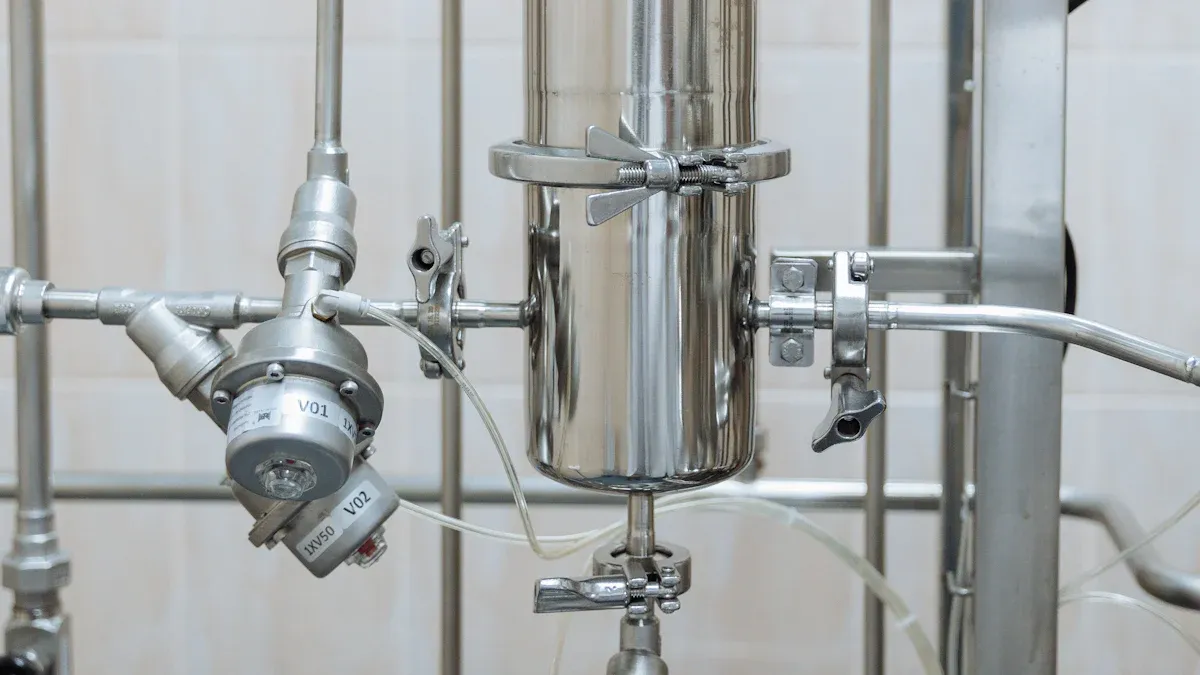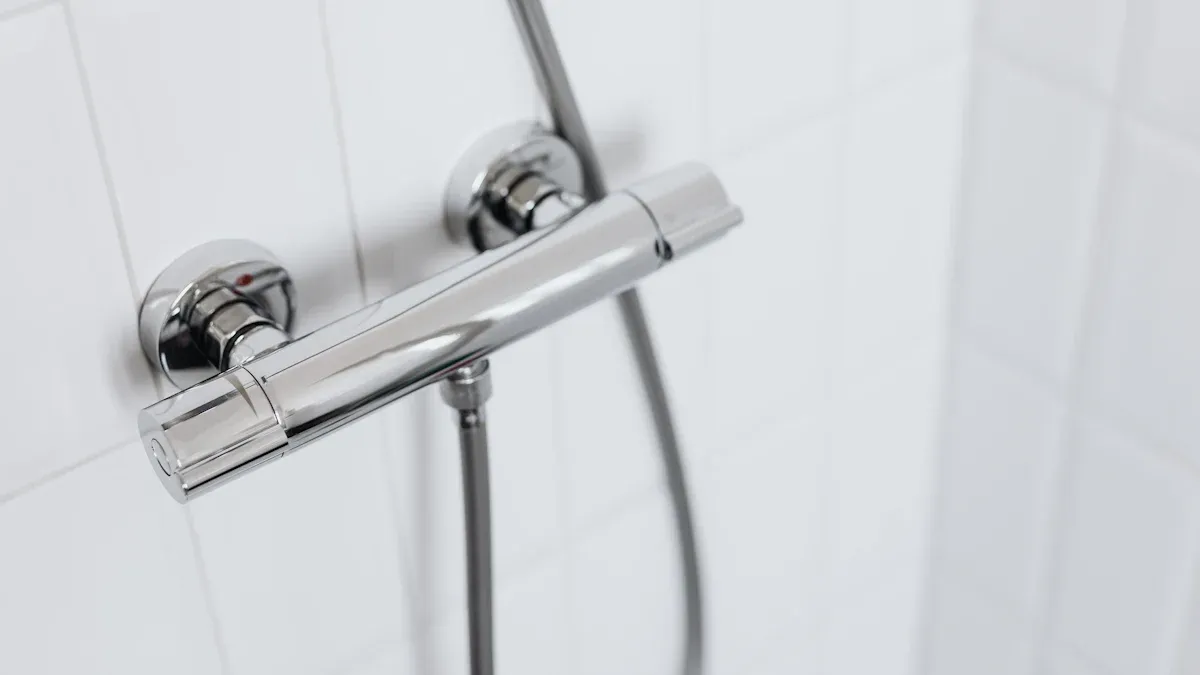
When selecting materials for plumbing, durability and performance are key factors to consider. Stainless Steel Fittings excel in these areas, offering exceptional resistance to rust and long-lasting reliability. They are designed to withstand high temperatures and pressure effortlessly. While they may come at a higher cost and demand precise installation, understanding these aspects ensures you make well-informed choices.
Key Takeaways
- Stainless steel fittings do not rust, so they work well in wet or chemical-heavy places. They last a long time in plumbing systems.
- These fittings cost more at first, but they last longer and need little care, which can save money later. Think about the full cost before deciding.
- Putting in stainless steel fittings can be tricky. Use the right tools and skills, or hire experts to avoid expensive errors.
Advantages of Stainless Steel Fittings

Corrosion Resistance
You’ll find stainless steel fittings to be highly resistant to corrosion. This material contains chromium, which forms a protective oxide layer on its surface. This layer shields the fittings from rust and damage caused by exposure to moisture or chemicals. If you need plumbing systems in environments with high humidity or chemical exposure, stainless steel fittings are an excellent choice.
Durability and Strength
Stainless steel fittings offer unmatched durability. They can handle heavy loads and resist physical damage, making them ideal for demanding applications. You won’t have to worry about cracks or breaks under pressure. Their strength ensures that your plumbing system remains reliable even in challenging conditions.
Heat and Pressure Resistance
When dealing with high-temperature or high-pressure systems, stainless steel fittings perform exceptionally well. They maintain their structural integrity under extreme conditions. You can use them in industrial or residential settings where heat and pressure are common. Their ability to withstand these factors ensures the safety and efficiency of your plumbing system.
Hygiene and Non-Toxic Properties
Stainless steel fittings are non-toxic and easy to clean. They don’t leach harmful substances into water, making them safe for drinking water systems. If hygiene is a priority, such as in food-grade or medical applications, these fittings are the ideal solution. Their smooth surface prevents bacteria buildup, ensuring a clean and sanitary environment.
Long Lifespan and Low Maintenance
You’ll appreciate the long lifespan of stainless steel fittings. They resist wear and tear, reducing the need for frequent replacements. Maintenance is minimal, as their corrosion resistance and durability keep them in excellent condition for years. Choosing stainless steel fittings means investing in a plumbing system that lasts longer and requires less upkeep.
Disadvantages of Stainless Steel Fittings
Higher Initial Cost
When choosing stainless steel fittings, you may notice their price is higher compared to other materials like PVC or brass. This is due to the cost of raw materials and the manufacturing process. Stainless steel requires advanced techniques to produce its durable and corrosion-resistant properties. While the initial investment might seem steep, it often pays off in the long run due to its longevity and low maintenance needs. However, for projects with tight budgets, this upfront cost can be a significant drawback.
Installation Challenges
Installing stainless steel fittings can be more complex than working with other materials. You need specialized tools and skills to ensure proper connections. For example, threading or welding stainless steel requires precision to avoid leaks or damage. If you lack experience or the right equipment, you might face delays or additional expenses. Hiring professionals for installation can help, but it adds to the overall cost of your plumbing project.
Repair and Replacement Difficulties
Although stainless steel fittings are durable, repairing or replacing them can be challenging. Their strength, while beneficial in most cases, makes cutting or modifying them more difficult. If a fitting becomes damaged, you may need specialized tools or professional assistance to fix the issue. This can increase downtime and repair costs, especially in critical systems where quick fixes are necessary.
Electrochemical Corrosion Risks
Stainless steel fittings are not entirely immune to corrosion. When they come into contact with other metals, electrochemical corrosion can occur. This happens when two different metals, such as stainless steel and copper, are connected in the presence of an electrolyte like water. Over time, this reaction can weaken the fittings and compromise the plumbing system. To prevent this, you should use insulating materials or ensure compatibility between metals in your system.
Comparison with Other Materials
Stainless Steel vs. Brass
When comparing stainless steel fittings to brass, you’ll notice key differences in durability and corrosion resistance. Brass fittings are softer and easier to install, making them a popular choice for residential plumbing. However, they are more prone to corrosion, especially in systems exposed to water with high chlorine content. Stainless steel fittings, on the other hand, offer superior strength and resist corrosion more effectively. If you need fittings for high-pressure or industrial applications, stainless steel is the better option. Brass may work well for smaller, low-pressure systems, but it lacks the longevity of stainless steel.
Stainless Steel vs. PVC
PVC fittings are lightweight and cost-effective, making them ideal for budget-conscious projects. They are easy to install and work well in low-temperature and low-pressure systems. However, PVC cannot handle extreme heat or pressure. It also degrades over time when exposed to UV light or certain chemicals. Stainless steel fittings excel in these areas, providing unmatched durability and resistance to heat, pressure, and chemical exposure. If you’re working on a system that demands long-term reliability and strength, stainless steel fittings outperform PVC by a wide margin.
Stainless Steel vs. Copper
Copper fittings are widely used in plumbing due to their excellent thermal conductivity and resistance to bacteria. They are also lightweight and relatively easy to install. However, copper is more susceptible to corrosion in acidic or high-salinity environments. Stainless steel fittings, in contrast, resist corrosion in a wider range of conditions. They also handle higher pressures and temperatures better than copper. If you need fittings for demanding environments, such as marine or industrial settings, stainless steel is the more reliable choice. Copper may suit residential systems, but it doesn’t match the durability of stainless steel.
Applications of Stainless Steel Fittings

Marine and Coastal Environments
You’ll find stainless steel fittings highly effective in marine and coastal areas. These environments expose plumbing systems to saltwater and high humidity, which can cause rapid corrosion in other materials. Stainless steel resists rust and maintains its strength even in these harsh conditions. This makes it a reliable choice for docks, ships, and coastal buildings. Its durability ensures long-term performance, reducing the need for frequent replacements.
Chemical and Industrial Plants
In chemical and industrial plants, plumbing systems often handle corrosive substances and extreme temperatures. Stainless steel fittings excel in these settings due to their resistance to chemicals and ability to withstand high pressures. You can rely on them to maintain safety and efficiency in demanding applications. Their non-reactive nature ensures they won’t contaminate sensitive processes, making them essential for industries like pharmaceuticals and petrochemicals.
Food-Grade and Hygienic Systems
Hygiene is critical in food processing and medical facilities. Stainless steel fittings meet these requirements with their smooth, non-porous surfaces that prevent bacteria buildup. They are easy to clean and maintain, ensuring a sanitary environment. You can use them in systems that handle drinking water, dairy products, or medical fluids. Their non-toxic properties make them a safe and reliable option for applications where cleanliness is a top priority.
High-Temperature and High-Pressure Systems
Stainless steel fittings perform exceptionally well in systems exposed to high temperatures and pressures. They retain their structural integrity under extreme conditions, ensuring safety and reliability. You’ll often see them in boilers, steam systems, and industrial pipelines. Their ability to handle these challenges makes them a preferred choice for both residential and commercial applications requiring robust performance.
Tips for Choosing Stainless Steel Fittings
Assessing Material Grades and Standards
When selecting stainless steel fittings, you should always check the material grade. Different grades, such as 304 and 316, offer varying levels of corrosion resistance and strength. For example, grade 316 contains molybdenum, which enhances its ability to resist harsh chemicals and saltwater. Look for fittings that meet industry standards like ASTM or ISO certifications. These standards ensure the fittings are reliable and suitable for your plumbing system.
Ensuring Compatibility with Plumbing Systems
Before purchasing, confirm that the fittings are compatible with your existing plumbing system. Check the size, threading type, and connection method. Using incompatible fittings can lead to leaks or system failures. If you’re unsure, consult a professional or refer to the manufacturer’s guidelines. This step ensures a secure and efficient installation.
Avoiding Common Selection Mistakes
Many people overlook factors like pressure ratings or temperature limits when choosing fittings. You should always consider the specific demands of your plumbing system. For instance, using fittings designed for low-pressure systems in high-pressure environments can cause damage. Avoid rushing the selection process. Take time to evaluate your system’s requirements.
Balancing Cost with Long-Term Value
While stainless steel fittings may have a higher upfront cost, they often save you money in the long run. Their durability and low maintenance reduce replacement and repair expenses. Consider the total cost of ownership rather than just the initial price. Investing in high-quality fittings ensures a reliable and long-lasting plumbing system.
Stainless steel fittings offer you unmatched durability, corrosion resistance, and hygiene. These qualities make them perfect for demanding plumbing systems. However, their higher cost and installation complexity might not suit every project. By weighing the advantages and disadvantages, you can decide if they meet your specific plumbing needs.
FAQ
What grade of stainless steel is best for plumbing fittings?
Grade 316 works best for plumbing. It resists corrosion from chemicals and saltwater, making it ideal for demanding environments like marine or industrial systems.
Can stainless steel fittings be used in drinking water systems?
Yes, stainless steel fittings are safe for drinking water. They don’t leach harmful substances and maintain hygiene, ensuring clean and non-toxic water delivery.
How do you prevent electrochemical corrosion in stainless steel fittings?
Use insulating materials between different metals. Ensure compatibility in your plumbing system to avoid reactions that weaken fittings over time.
Post time: Jun-03-2025
